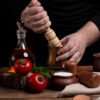Cooking in Clay, Living in Memory
Have you ever lifted the lid of a clay pot and felt the steam hit your face, rich, earthy, and somehow more “alive” than anything that comes from stainless steel or non-stick pans?
The aroma isn’t just food. It’s a memory. Growing up, my grandmother simmered lentils in a clay pot that had tiny cracks around the edges. The stew would bubble slowly, infusing the house with warmth. Later, when she switched to aluminum and then Teflon, something changed. The meals were faster, shinier, easier to clean, but that deep, soulful taste felt like it had slipped away.
This is why people around the world are revisiting clay pot cooking today. In an era of fast food and instant gratification, clay pots remind us of what we’ve lost: flavor, patience, and a connection to the earth itself. Let’s journey through history, tradition, and science to see why clay cookware may be old-fashioned, but never truly outdated.
Why This Topic Matters: A Lost Kitchen Tradition
When you step back, the shift from clay pots to modern cookware isn’t just about convenience. It’s about culture. Clay has been humanity’s oldest cooking vessel, dating back over 10,000 years. From Roman testum pots to Indian handi, from Moroccan tagines to Japanese donabe, clay has always been part of the kitchen story.
Modern cookware, steel, aluminum, Teflon, and ceramics promised us speed, shine, and durability. And to be fair, they delivered. But in the process, we lost more than we realized: taste, texture, and even health benefits tied to clay’s natural properties.
The question is: what do we gain back when we return to clay?
The Ancient Science of Clay Pot Cooking
Clay isn’t just rustic, it’s functional. What really stands out is how clay interacts with food during cooking:
-
Moisture Retention: Clay is porous. It allows slow evaporation and natural steaming, keeping food moist without adding extra fat.
-
Even Heat Distribution: Unlike metal pans that can create hotspots, clay radiates heat gently, cooking food evenly from all sides.
-
Alkaline Properties: Many studies suggest that clay can neutralize acidity in foods, balancing flavors naturally.
-
Nutrient Preservation: Because it cooks at a lower, gentler temperature, nutrients aren’t destroyed as quickly as with high-heat modern cookware.
You might never guess it, but something as simple as clay actually has chemical and physical advantages that shiny non-stick pans can’t replicate.
Global Stories: Clay Pots in Different Cultures
India: The Humble Handi
In many Indian households, clay pots are still used to make dal, biryani, or curd. My own aunt insists that yogurt set in clay pots tastes creamier and richer than anything in stainless steel.
Morocco: The Tagine
The Moroccan tagine—with its cone-shaped lid—is a clay masterpiece. Vegetables, meat, and spices cook slowly, producing dishes layered with flavor. The shape isn’t decorative; it channels steam back into the food.
Japan: The Donabe
Japanese clay pots, or donabe, are central to family meals. Imagine sitting around a bubbling pot of rice or hot pot at the table, the vessel itself becoming part of the dining experience.
Latin America: The Cazuela
In countries like Mexico and Colombia, cazuelas are used for soups and stews. The earthy clay adds a distinct flavor you simply don’t get from stainless steel.
When you hear these stories, it feels less like nostalgia and more like proof: clay pots are global, timeless, and deeply human.
Clay Pot Cooking Benefits vs. Modern Cookware
To make things clearer, here’s a side-by-side comparison:
| Feature / Benefit | Clay Pot Cooking Benefits | Modern Cookware (Steel, Non-Stick, Aluminum) |
|---|---|---|
| Flavor | Deep, earthy, richer taste | Neutral or sometimes metallic aftertaste |
| Moisture | Retains natural juices, no extra oil needed | Often dries food unless fat is added |
| Nutrient Preservation | Gentle cooking keeps nutrients intact | High heat can destroy vitamins/minerals |
| Health | Alkaline clay balances acidity | Non-stick coatings may release chemicals |
| Durability | Fragile, requires care | Long-lasting, less fragile |
| Convenience | Slow cooking, more effort | Fast cooking, easy cleaning |
| Cultural Connection | Deeply tied to tradition & heritage | Practical, modern, less symbolic |
Here’s what this really means: modern cookware wins in speed and ease, but clay wins in taste, nutrition, and cultural richness.
My Experience: Cooking in Clay vs. Steel
I’ll admit, I was skeptical the first time I tried cooking rice in a clay pot. It felt fragile, and I worried it would break. But when I lifted the lid, the rice smelled smoky, earthy, and had a subtle sweetness I’d never noticed before. A week later, I made the same dish in a steel pan. It was fine, quick, and clean. But it didn’t make me stop, breathe, and savor. That’s the difference.
And it’s not just me. Friends who’ve switched back to clay swear their stews, beans, and curries taste like something from their childhood.
Authoritative Insights: What Experts Say
The Smithsonian once noted that “clay vessels are not just containers but active participants in cooking.” National Geographic, in its features on Moroccan cuisine, emphasized how the tagine’s clay structure enhances flavor by recycling steam.
Food scientists point out that porous clay “breathes” during cooking, enhancing aroma. Meanwhile, studies from cultural research institutes in India and Latin America show that food cooked in clay has measurably higher mineral content, like calcium and iron, from the pot itself.
When experts from history and science agree, it’s clear: clay cookware is more than nostalgia, a science-backed tradition.
Why Clay Fell Out of Favor
It wasn’t that clay stopped working. It was that life sped up. With industrialization came aluminum, steel, and eventually Teflon. These materials promised durability, shine, and most importantly, convenience.
Clay cracked, needed soaking, and took time. Modern cookware offered the opposite: fast, sleek, and dishwasher-friendly. And so, slowly, clay was set aside.
But here’s the twist: in chasing convenience, we traded away flavor, nutrition, and cultural identity.
What We’ve Lost and What We Can Regain
When you step back, it feels like modern kitchens gave us speed but robbed us of depth. Clay pots symbolize patience, tradition, and an earthy connection. The benefits aren’t just physical but emotional.
-
We’ve lost the slow ritual of cooking, where meals took time and attention.
-
We’ve lost flavors infused by natural materials instead of artificial coatings.
-
We’ve lost a cultural link—grandmothers teaching grandchildren to stir a bubbling clay pot.
But the good news? We can regain it. Many chefs and home cooks are bringing clay back, not as a relic, but as a revolution against fast food culture.
FAQs: Clay Pot Cooking Benefits
Q1: Can clay pots be used on modern stoves?
Yes, but with care. They’re best on low flame or with a heat diffuser. Sudden temperature changes can crack them.
Q2: Are clay pots safe?
Absolutely, as long as they’re lead-free and unglazed. Traditional unglazed clay is safest for health.
Q3: Does food taste different in clay pots?
Yes—many describe it as richer, smokier, and more “rounded.” It’s like the pot itself adds seasoning.
Q4: Are clay pots hard to clean?
They require hand washing and drying, but with regular seasoning and care, they last for years.
Final Thoughts: Rediscovering the Clay Legacy
Clay pots may seem outdated, but when you really think about it, they offer something modern cookware can’t. They’re not just vessels; they’re storytellers. Every stew, every curry, every slow-simmered dish carries the echo of centuries.
What we’ve lost in speed and shine, we can regain in taste, health, and heritage. So maybe the next time you’re tempted to buy another stainless pan, consider trying clay. You might find that what you gain isn’t just better food, but a deeper connection to the way humans have cooked for thousands of years.



